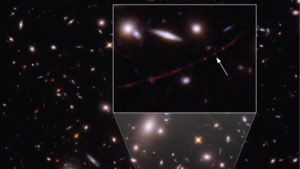Earendel: Difference between revisions
George Swan (talk | contribs) (more details) |
George Swan (talk | contribs) (more details) |
||
| Line 4: | Line 4: | ||
Detection of the star was possible because it was at the focus of a [[Gravitational lens]].<ref name=Space2022-03-30/> | Detection of the star was possible because it was at the focus of a [[Gravitational lens]].<ref name=Space2022-03-30/> | ||
The official designation is ''WHL0137-LS'', and it is at least 50 times the mass of [[Sol]], our sun, and on the order of a million times as bright. The unofficial name, Earendel, is a word from the [[Old English]] language, meaning "first light", as this star shone within the first billion years of our Universe. | |||
[[Brian Welch]], the lead author of the study that announced the star, said ''"This finding gives us an opportunity to study a star in detail in the early universe"''.<ref name=Space2022-03-30/> | |||
==References== | ==References== | ||
Revision as of 12:18, 30 March 2022

On March 30, 2022, Astronomers using the Hubble Space Telescope announced they had found a star they dubbed Earendel that was 12.9 billion light-years from Planet Earth.[1] At 12.9 billion light years it would be not only the most distant star yet detected, but also the oldest.
Detection of the star was possible because it was at the focus of a Gravitational lens.[1]
The official designation is WHL0137-LS, and it is at least 50 times the mass of Sol, our sun, and on the order of a million times as bright. The unofficial name, Earendel, is a word from the Old English language, meaning "first light", as this star shone within the first billion years of our Universe.
Brian Welch, the lead author of the study that announced the star, said "This finding gives us an opportunity to study a star in detail in the early universe".[1]